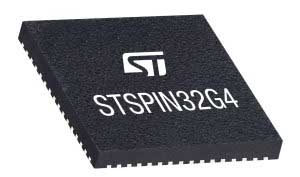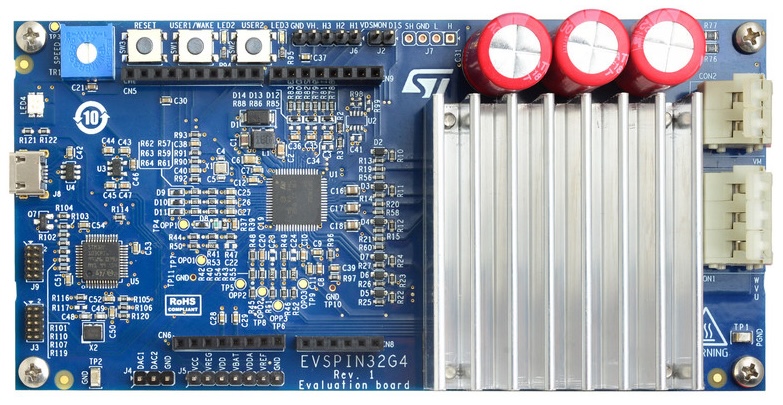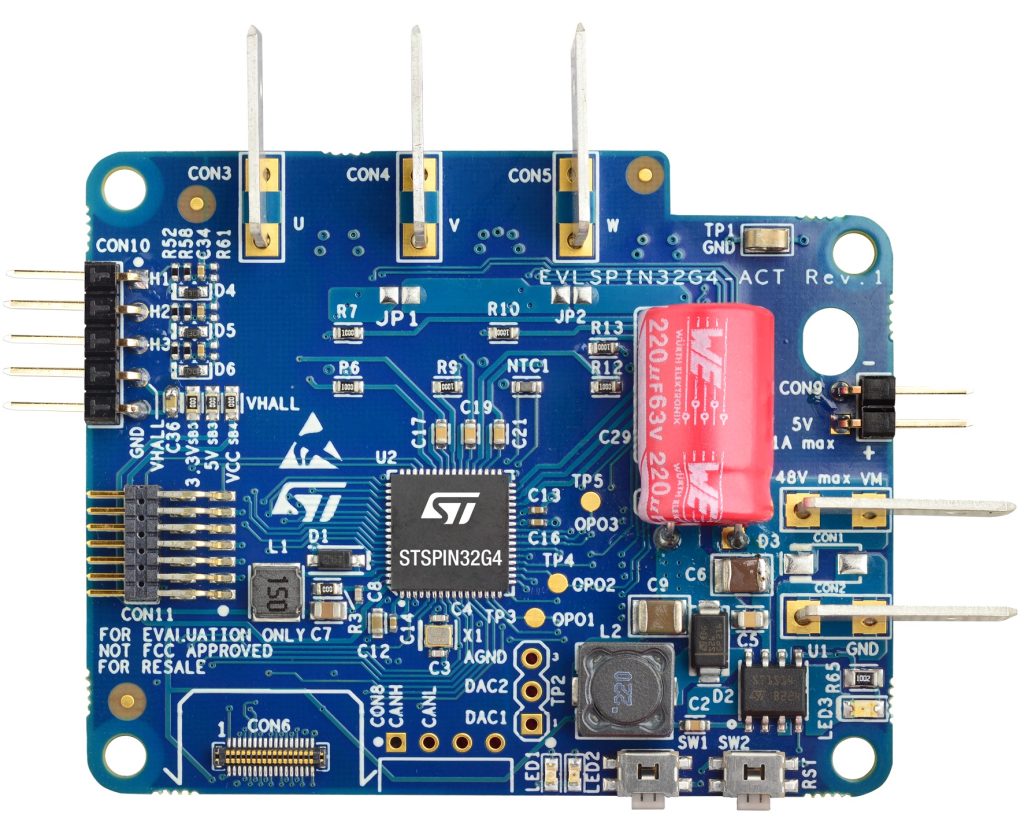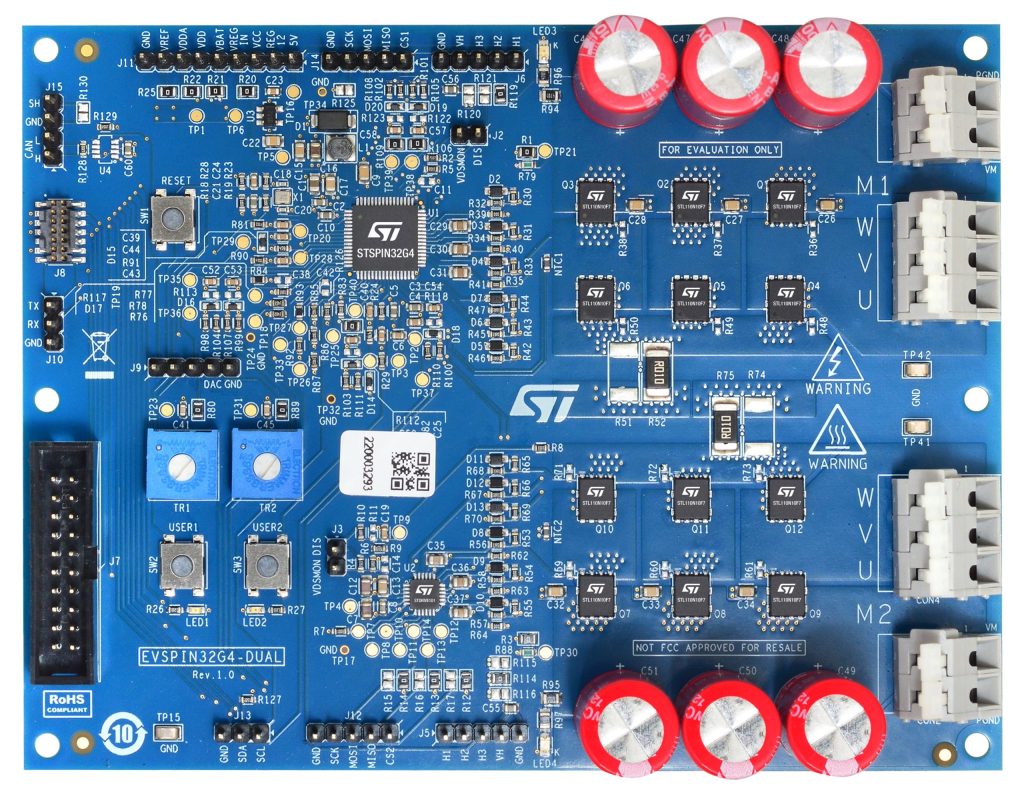The STSPIN32G4 integrates a three-phase gate driver, an STM32G431, and a power management system under one package to solve major engineering challenges, thus enabling new applications. While ST continues to offer STSPIN motor drivers, we also realized that engineers still face several conundrums. Designers want to run more powerful applications but must also shrink their PCBs and reduce costs. Similarly, applications demand more efficiency, but improving it by a few decimal percentage points remains a struggle. ST engineers thus launched the STSPIN32G4 because no other integrated motor controller offered such a powerful mainstream MCU and such a flexible power management system.

STSPIN32G4 and the first challenge: How to make things more powerful in a smaller design?
More power under one roof

Let’s take the example of an engineer working on a high-end vacuum cleaner with a high-speed motor. The MCU inside the STSPIN32G4 will stand out, in this instance, because of its computational throughput. A lower-performance CPU core means a lower conversion rate when designing a field-oriented control (FOC) sensorless application. The engineer in the vacuum cleaner example would have to use two or three shunt resistors to compensate for the MCU’s lower performance. On the other hand, the greater computational throughput means a single shunt is sufficient. As a result, using the STSPIN32G4 enables the creation of a powerful application with fewer components.
More peripherals in one device
A team working on a collaborative robot or a guided vehicle would also appreciate the MCU in the STSPIN32G4 for reasons other than the bump in DMIPS. In this instance, engineers must drive two sets of wheels, but traditional motor controllers don’t have enough analog-to-digital converters to handle such a task. As a result, engineers end up using two motor drivers. The STSPIN32G4 is unique because it provides two sets of PWM timers and 12-bit ADCs, among other things. It, therefore, becomes possible to drive two motors with just one integrated device.
Saving 65% space
While it’s impossible to enumerate all the features in the STSPIN32G4, the reality is that its integrated nature is one of the best ways to solve the space challenge. Motor control applications are increasingly smaller, whether for convenience, costs, or to stand out better. Thanks to its integrated nature, the STSPIN32G4 helps reduce the overall design size by 65% compared to discrete solutions. Practically, it allows engineers to put the control system at the back of the motor and design a much smaller e-bike, vacuum cleaner, or power tool, among other things.
STSPIN32G4 and the second challenge: how to make things more energy efficient while keeping costs down?
A more efficient power management
According to our benchmarks, using the new device lowers the overall power consumption by 3% to 5% compared to a system that uses external components. A saving of just a single percent already has a significant impact. ST provided such power efficiency by bringing the typical standby consumption to only 15 µA thanks to a very low-quiescent regulator. Hence, we expect engineers to create significantly more compact designs without needing an external cooling system, thus lowering the BoM.
The motor controller also supports a supply voltage of up to 75 V, compared to only 48 V previously. Additionally, the STSPIN32G4 comes with an over-current protection mechanism and a drain-source voltage (VDS) monitoring system that acts as a redundancy. It monitors the external MOSFETs and turns all gate driver outputs off if it detects an over-voltage condition. As a result, we expect engineers to use the STSPIN32G4 in appliances. Indeed, a white good connected to a grid often suffers from wide voltage variations from the mains. The greater supply voltage range and protection features of the new device will better handle these abnormal conditions.
A more flexible power management
Engineers sometimes shy away from integrated solutions, fearing they may restrict their optimization capabilities. Hence, ST ensured a high level of customization. For instance, developers can program registers through an I2C interface to use the STSPIN32G4’s VCC buck converter. Moreover, we published an application note showing how to use the buck regulator in a buck-boost configuration by adding a few external components. Finally, engineers can bypass the buck and LDO regulators to rely on only an external Vcc supply.
Teams that designed a highly precise power supply to meet the stringent requirements of their application can, thus, ignore the STSPIN32G4 regulators. In contrast, others can simplify their designs by using its VCC buck converter to power a few external components, like a memory module. Similarly, developers can choose to enable or disable the standby mode. Such a feature is vital for products like power tools. When users pick a drill after months or even years, they must use it immediately. In such a case, engineers will want to completely disconnect their system from the battery to maximize its usage.
Engineers also get a lot more flexibility in how they drive a motor. They could use a 6-step driver circuit or a field-oriented control, both with or without a sensor and with one, two, or even three shunts. It gives developers the ability to control how much measurement data they gather. Consequently, it also becomes possible to qualify an STSPIN32G4 and use it in many different applications, which can help a company shorten its time to market and optimize its operations.
How to get started

ST launched two development boards to enable teams to test and experiment with the STSPIN32G4. The EVSPIN32G4 uses STL110N10F7 power MOSFETs and a heat sink to allow an output current of up to 20 A RMS. As a result, teams can push the new devices to develop more powerful designs. However, ST is also mindful that not every designer will use the STSPIN32G4 in high-powered systems. Hence, we are also launching the EVSPIN32G4NH, a similar development board without passive cooling; NH at the end of the nomenclature stands for “no heat sink”. We also updated the X-CUBE-MCSDK to support the new boards and devices.

More recently, our teams released two reference designs. The EVLSPIN32G4-ACT drives a three-phase brushless motor supporting up to 5 ARMS and can manage a supply input of 48 V for a surprising 250 W total power in a board measuring only 62 mm x 50 mm. Additionally, it can connect to the STWIN.box (STEVAL-STWINBX1) to rapidly create a high-speed data logger. Thanks to our FP-IND-DATALOGMC software pack and Quick Start Guide, engineers have a step-by-step process to connect both boards and run applications that can gather data from the sensors on the STWIN.box and the motor itself. We even offer a GUI to help visualize the information.

The other board is the EVSPIN32G4-DUAL, which combines the STSPIN32G4 and the STDRIVE101, a triple half-bridge gate driver. As a result, the board can drive two three-phase brushless motors for up to 10 ARMS output current and a supply of 74 V thanks to two power stages. Thanks to the operational amplifiers of the STSPIN32G4, it’s possible to have a sensor-less system with a single shunt current sensing or use Hall sensors and encoders with the embedded MCU. Put simply, the reference design shows how to create a powerful dual motor application in a small factor for home appliances, e-mobility, pumps, tools, and more.












